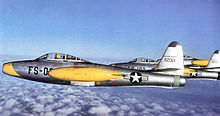
Quartier La Horie is a French Army base. It is located in the Moselle département, about 2 miles(3 km) west of the town of Phalsbourg, on the north side of the Route nationale 4 (N4) Highway adjacent to the village Saint-Jean-Kourtzerode; 29 miles (47 km) northwest of Strasbourg.

The 406th Air Expeditionary Wing is a provisional air expeditionary unit assigned to the United States Air Force's Third Air Force, stationed at Ramstein Air Base, Germany. Its components conduct tactical airlift, personnel recovery, casualty evacuation, and attack missions in support of United States Africa Command.

The 86th Air Division is a former designation of the 86th Airlift Wing, a United States Air Force organization. It was assigned to United States Air Forces in Europe at Ramstein Air Base, West Germany. It was inactivated on 14 November 1968. Its mission was the air defense of NATO-controlled airspace in Western Europe.

The 359th Fighter Group was a United States Army Air Force fighter unit that was active during World War II. Following organization and training in the United States, the group deployed to the European Theater of Operations, operating from RAF East Wretham. The fighter group flew 346 combat missions over continental Europe and claimed 373 enemy aircraft in aerial combat and strafing attacks; probable destruction of 23; and damage to 185. It was awarded the Distinguished Unit Citation for its actions. The group flew its last mission on 20 April 1945, then returned to the United States for inactivation.

The 188th Rescue Squadron is unit of the New Mexico Air National Guard. It is assigned to the 150th Special Operations Wing located at Kirtland Air Force Base, New Mexico.

The 510th Fighter Squadron is part of the 31st Operations Group at Aviano Air Base, Italy. It is a combat-ready F-16CM fighter squadron prepared to deploy and fly combat sorties as tasked by NATO and US combatant commanders.

The 128th Airborne Command and Control Squadron is a unit of the Georgia Air National Guard 116th Air Control Wing located at Robins Air Force Base, Georgia. The 128th is equipped with the E-8C Joint STARS.

The 525th Fighter Squadron is a United States Air Force unit. It is assigned to the 3d Operations Group at Joint Base Elmendorf–Richardson, Alaska. The squadron was first activated as the 309th Bombardment Squadron in February 1942. After training in the United States, it deployed to the Mediterranean Theater of Operations, where it became the 525th Fighter-Bomber Squadron and engaged in combat until the spring of 1945, earning two Distinguished Unit Citations. After VE Day, the squadron became part of the occupation forces in Germany. Briefly inactivated in 1946, it returned to Germany a few months later.

The 418th Test and Evaluation Squadron is an active United States Air Force unit assigned to the 53rd Test and Evaluation Group, and stationed at Davis-Monthan Air Force Base, Arizona, where it was activated on 1 October 2021.

The 526th Fighter Squadron is an inactive United States Air Force unit. Its last assignment was with the 86th Operations Group, based at Ramstein Air Base, Germany. It was inactivated on 1 July 1994.

The 86th Operations Group is the flying operational component of the 86th Airlift Wing, United States Air Force. The group is stationed at Ramstein Air Base, Germany.

The 514th Fighter-Interceptor Squadron is an inactive United States Air Force unit. Its last assignment was with the 86th Air Division, based at Ramstein Air Base, Germany, where it was inactivated on 8 January 1961.

The 512th Fighter Squadron is an inactive United States Air Force unit. Its last assignment was with the 86th Fighter Wing at Ramstein Air Base, Germany, where it was inactivated September 1994.

The 86th Fighter-Interceptor Squadron is an inactive United States Air Force unit. Its last assignment was with the 79th Fighter Group at Youngstown Air Force Base, Ohio, where it was inactivated on 1 March 1960.

The 568th Air Defense Group is a disbanded United States Air Force organization. Its last assignment was with Air Defense Command (ADC)'s 4709th Air Defense Wing at McGuire Air Force Base, New Jersey, where it was inactivated in 1954. The group was originally activated as the 568th Air Service Group, a support unit for a combat group at the end of World War II on Guam, but was soon inactivated.

The 502d Air Defense Group is a disbanded United States Air Force organization. Its last assignment was with Air Defense Command (ADC)'s 4708th Air Defense Wing, at Youngstown Municipal Airport, Ohio. It was inactivated on 18 August 1955.

The 406th Air Expeditionary Group is the operational flying component of the 406th Air Expeditionary Wing. It is a provisional unit assigned to the United States Air Forces in Europe.

The 509th Tactical Fighter Squadron is an inactive United States Air Force unit. It was last assigned to the 10th Tactical Fighter Wing at RAF Alconbury, England, where it was inactivated on 30 December 1992.

The 116th Operations Group is a Georgia Air National Guard unit assigned to the 116th Air Control Wing. The unit is stationed at Robins Air Force Base, Georgia. The 116th Group controls all operational Northrop Grumman E-8C Joint STARS aircraft of the 116th Air Control Wing. It was activated in 1992, when the Air Force implemented the Objective Wing organization, and was successively equipped with the McDonnell Douglas F-15 Eagle and the Rockwell B-1 Lancer before converting to the E-8C in 2002.



























